#diegetic fourth wall break :)
Text
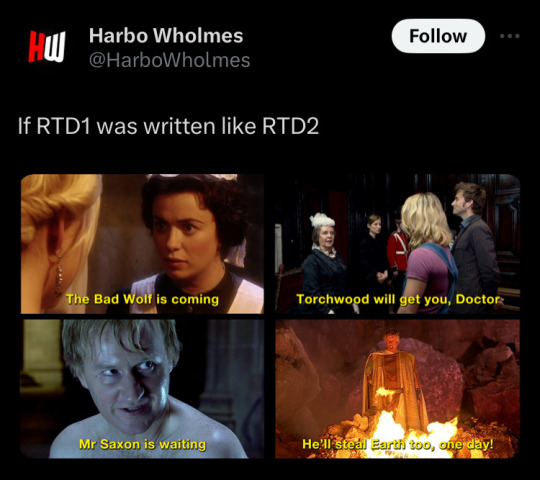
saw this on the forbidden app could not resist reposting because it’s true. “the one who waits is almost here” is lazy LAZY writing. stop dangling lore in front of our faces… make it SUBTLE. show not tell…
did russell go to the chibnall school of bad screenwriting before his return because these episodes do genuinely feel like they’ve been created by a different person entirely than the emotionally intelligent, thoughtful showrunner who gave us the first four series
#i want to like it… and some aspects are cool; the meta plots and the fourth wall breaking and non-diegetic music and stuff… but#the exposition dumps are truly s11 level#it’s so… CBBC.#moffat save us steven come save us stevennn#dw#doctor who#doctor who spoilers#the devil’s chord#space babies#rtd2#russell t davies#doctor who negativity#doctor who meta#fifteen#fifteenth doctor#ncuti gatwa#bad wolf#jamie.txt#dw negativity
171 notes
·
View notes
Text
"I thought that was non-diegetic!" is now my VERY FAVORITE leaning-on-the-fourth-wall line ever.
#spoilers#although i will attempt to mitigate the spoilers by keeping the rest of the tags#buried underneath a row of chatter#so for the unfamiliar 'diegetic' music is music that exists in-universe#e.g. music on a radio or in a concert#'non-diegetic' music is the soundtrack that only the audience can hear#and sometimes the one can fade into the other#so into the spoilery section#doctor who spoilers#doctor who#facing a musical villain and x character says 'do you hear that music?' before magical music notes drag them off#and the doctor says 'i thought that music was non-diegetic!'#... so the doctor is now aware of the fourth wall???#are we going to be breaking the fourth wall for part of this season???#anyway yes fifteenth doctor is off to a very strong start imho
135 notes
·
View notes
Text
and ULTIMATELY. shes going to be ok. its going to be ok. its devastating for sure but its not like. entirely sad. to me. specifically because of the way she walks away from us at the end
#fourth wall break over the course of the show a) somethibg that is visible diegetically and b) somewhat of a coping mechanism#after the end of e5 she doesn't fourth wall break again when shes w/ the priest i don't think. in itself Insane#but the fact that after All That she leaves us behind. shes staying present in the world as opposed to maintainkng distance and joking abt#again. you have to stop talking to people like you're doing a stand up routine!! and she does!! because some things aren't fucking funny!!#i am. So late. to the party. but that's ok#neon has thoughts#television tag
4 notes
·
View notes
Text
the spear cuts through water: slaps like hell. act 4 has instantly elevated this book into contention for best thing i’ve read this year
3 notes
·
View notes
Text
also, based on the neostigmine file, i'm guessing i just unlocked that lock where dio blackmails us with the axelavir
#cog plays games#cog plays zero escape#ze#ze vlr#ze spoilers#vlr spoilers#how much do the files exist diegetically?#a lot of them are written on a meta-level#but the people in the room w/ you acknowledge the fact that you opened up and found a puzzle#but neither they nor sigma seem to be aware of the contents of the files#even the ones not explicitly breaking the fourth wall#like clover and sigma are acting like they don't know what neostigmine does#when i just read a file saying it counteracts tubocarine or whatever
1 note
·
View note
Text
Okay absolutely off the wall Doctor Who theory time.
They are trapped inside a television show. An outrageous claim I know buuuut I do have a fair bit of evidence. First something kinda unsubstantial, the sonic screwdriver literally looks like a TV remote, and in the episode the Doctor hit the Mute button.
Second: the key art for the penultimate episode "The Legend of Ruby Sunday" features a TV set
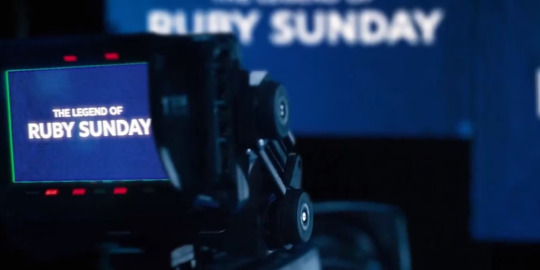
Third: The sheer amount of fourth wall breaks in the past four episodes trumps what we've seen in the whole of the revival.
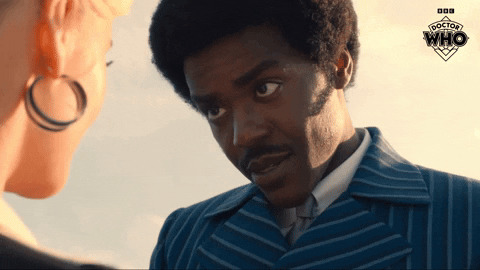
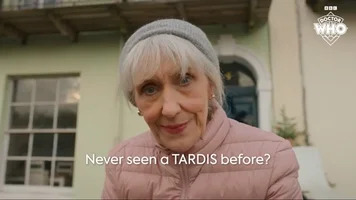
Fourth: At the end of "The Devil's Cord" a music number saying there's "Always a twist", and an actress that has been popping up all over this new era is 'Susan Twist'. She keeps popping up, because 'There's Always a Twist'.
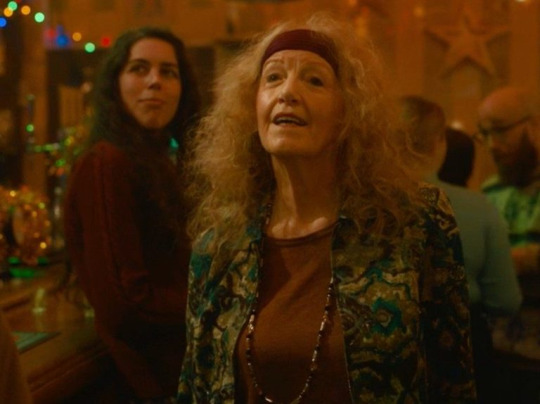
Fifth: The Doctor mentions that he thought the music was "Non-diegetic", meaning he could hear the music in the scene and assumed it was just part of the show, until Ruby mentioned she could hear it. Implying that whenever we hear the Non-diegetic music in the show so can the Doctor.
Thank you for listening to my absolute crackpot theory.
#doctor who#doctor who season 1#15th doctor#fifteenth doctor#ruby sunday#doctor who theory#ncuti gatwa#millie gibson
7K notes
·
View notes
Text
More favourite stupid video game tropes, Hallowe’en edition:
Games where you start out playing as a character who’s presented as a totally plausible protagonist, but then they’re horribly killed and the actual player character is someone different
Tutorials that describe the basic mechanics from an in-character perspective in a way that seems like a silly fourth-wall-breaking joke, then much later this casual blurring of the fourth wall is revealed to have horrifying narrative implications
Fakeouts where it looks like you messed up and died, but really it’s a puzzle and you have to do something during the fake gameover screen to “solve” it
Reality-warping powers being represented as the ability to fuck with the game-mechanical substrate; e.g., teleportation in a 2D action game being represented by letting the player screen-wrap
Brainfuck segments where you’re suddenly playing as the monster and you have to have a boss fight against your own player character or something
Puzzles where the obstacles are the appendages of some unfathomably huge unseen creature, and you have to, like, poke its tentacles in the correct order to get them to move out of the way
Subtly impossible level layouts, like a corridor that makes four or five left turns in a row without intersecting itself
When a game whose narrative has heretofore acknowledged no diegetic separation between the player and the player character suddenly breaks its own rules and addresses the player directly
When you’re in a suspiciously calm and peaceful area, then something happens to alter your perceptions and it’s revealed that it was all an illusion and the Happy Shiny People were secretly zombie demon ghosts all along, and they all turn to face the camera and go “EEEEEEEE”
When there’s a guy with a detachable head
#gaming#video games#game design#tropes#horror#unreality#metatextual wankery#halloween#hallowe'en#violence mention#death mention#swearing
7K notes
·
View notes
Text
73 yards theory: The woman didn't say anything in particular to make everyone run away from Ruby. Instead, interacting with her broke the perception filter, which was the Fourth Wall.
This season has multiple moments of breaking the Fourth Wall already. For example, the wall-breaking aspects of The Devil's Chord, like the glances and winks into the camera, the Doctor's "non-diegetic" music comment, and the NuWho music themes that Ruby started to sing when Maestro split open her soul.
Additionally, 73 Yards had no title sequence, and other aspects of this episode could be hints at wall-breaking.
The knowledge Ruby retained of visiting Wales a third time at the end of the time loop (rather than cross-temporal memory) could be non-diegetic knowledge; when everyone turns their heads back towards Ruby after interacting with the woman, the shots are angled so that they look directly into the camera—this could imply that rather than looking at Ruby, they're looking at the audience, and therefore becoming aware that they are not real.
Pushing it further, Ruby is the camera (or more metaphorically, the perspective character). And finally, when Ruby fulfils the timeline and dies, the shot at the end of the episode becomes from the perspective of Ruby as the woman, and so interacting with the woman could be likened also to interacting with a camera, thus breaking the Fourth Wall. This idea of the woman as camera is supported by the insinuation in the same section that the woman follows Ruby as a kind of "life flashing before one's eyes" event at the end of Ruby's life—she is an Observer, an objective observer of her own life, existing outside of the narrative.
Ruby mentioned to Kate that there were some things that she just knew about the woman, like that she/Ruby would die if she attempted to separate them by boarding a boat. This was linked to the idea of the woman as being/having a perception filter, like the TARDIS, which made her perpetually indistinct. Breaking the perception filter fills someone with the knowledge that they are not real.
The people constantly say "Ask her" because as one of the protagonists, the world actually revolves around Ruby. I imagine one would feel a lot of resentment at having one's doubts at one's cosmic significance confirmed, and then being able to put a face to someone to whom some of the blame for your cosmically insignificant existence could be assigned.
Of course, Ruby initially believes that "Ask her" refers to the woman, but the woman is Ruby. So in either case, the "her" refers to Ruby; and the ambiguity is deliberate, both because of the reveal that Ruby is the woman and because the statement is so accusatory that it could mean "Ask the woman" (and therefore break the Fourth Wall yourself) or "Ask Ruby" (who is the protagonist and somewhat to blame for everyone else being side characters or background characters).
263 notes
·
View notes
Text
I. Introduction
A while ago, I wrote on how Jack Slash was a prime example of how Worm approaches metatextual commentary. Wildbow has a general tendency in his first two serials especially to identify common story tropes and give them in-universe justifications. Jack Slash in particular is a response to the tendency for writers to give plot armor to the Joker and similar sorts of popular villain characters. The out-of-story justification of the authors ("we can't have someone just shoot him, that's boring, besides everyone loves this guy look at him go") becomes an in-story aspect of his powers: an ability to subtly influence other capes behavior allowing him to always escape danger. Plot armor transformed into an in-universe mechanic that characters are aware of, react to, and work against.
Notably, this tendency is never used to highlight the status of wildbow's characters as characters— there is no fourth-wall breaking or attempts to undermine the audience's perception of the story as containing essentially a self-contained world running on its own internal logic. But this certainly isn't the only way you could comment on Joker-type charcter's plot armor: Funny Games covers similar ground using the opposite trick, repeatedly having its home-invader villains draw attention to how they're characters in a story, and that whether they win or lose is determined wholly by the author's will. Director Michael Haneke continually draws his audience into the story only to violently and repeatedly pull them out with suspension-of-disbelief-shattering acts on the villains part. It's The Treachery of Images as a horror movie.
Together, Worm and Funny Games showcase two different approach to explaining why the villain gets to live another day. If you can explain their deal using only the internal logic of the story ("Jack has a power that lets them escape consequences"), then the author is giving a diegetic justification for the trope justified by mechanisms of the story's universe. If you can't explain their deal without reference to them being characters in a narrative ("Paul can talk to the audience and rewind time because he's a fictional character and can do whatever the author says he can do") then its a "narrative" or nondiegetic justification for the trope.
These can be combined. Seidlinger's Anybody Home? used them together for awkward effect: serial killers perform acts that get recorded by some mysterious "camera" that produces a log of their events, which through mystical and mysterious means gets distributed to film producers and adapted into horror movies. Killers have fully "narrative" reasons for following horror tropes—they know they have an audience and are behaving for their benefit. But the story suffers from its awkward in-story justification, its "mechanical" framing: the audience the killers are acting for are other people within the story's universe, not the readers of the book. Characters realize they're "victims" in a story, but they're framed not as existing fully for the story but as normal people who got caught within a story, stuck in it like one gets caught in a storm.
In this post I want to highlight some more elegant ways of combining the mechanical and narrative approaches to metafiction, especially in regards to plot armor. I'll be commenting on wildbow's second serial Pact, Homestuck, and Eidolon DISKA, and heavily spoiling all of them. I've divided them into sections so readers can avoid spoilers or skip over works they're uninterested in, though they're not separate essays. I'd maybe recommend checking out DISKA if you haven't. Its great. Alright then.
II.
Pact and the otherverse gives its characters diagetic reasons for following tropes that align with narrative rules though its magic system. Otherverse magic largely involves telling the universe a story and hoping that your behavior has enough symbolic resonance that it believes you. A lot of the magic spells work on a "I dunno, this feels like it would work" logic.
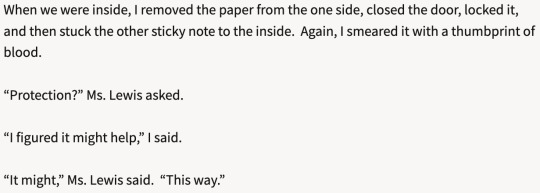
This means that characters need to be aware of how characters in good stories would act, and often need to behave in a way that is believable if they were characters in a story. The result is that Blake Thorburn ends up purposefully trying to emulate a monster from a horror story, purposefully playing into the tropes of such a character. He acts like a specific type of story character, not because he's broken the fourth wall and knows he's in a horror story, but because he knows convincing the universe that he's a horror villain will likely lead to the universe letting him survive just a little bit longer before he collapses into an exsanguinated heap.
However, Pact's approach to the specific mechanics and abilities of Blake and other monstrous entities of his ilk is much more in-line with how wildbow previously approached Jack Slash. Horror-movie style monsters are a grab-bag of entities called "Boogeymen" within the setting, with little in common outside of previously being people who had fallen through the cracks of reality and climbed out of the abyss changed.
The tropes of slasher movies are once again given mechanical justification: the monster drives conflict and acts unpredictably because being feared gives its more of a foothold in reality. It can't stay dead (and keeps returning for sequels) because it can always climb back out of the abyss again, or be summoned by Scourges to be used against their enemies. Some of the ways the in-universe boogieman mechanics reproduce these tropes are explicitly narrative justifications—they're stronger if the universe sees their ends as especially "iconic," and Blake seems to be empowered the most when he leans into character and goes on a rampage— but for the most part, you could explain their deal without having to refer to their roles as characters in a narrative.
III
The same couldn't be said for Homestuck's take on the serial-killer trope, which is explicable pretty much only in non-diagetic terms. Which is interesting insofar as its one of the only parts of Homestuck that doesn't at least provide a diagetic fig-leaf for a character following a cultural script.
Much like Pact's Otherverse, Homestuck also formalizes many narrative tropes as diagetic, in-universe mechanical laws of its setting. However, it doesn't bother giving justifications for why the setting has such mechanics. There's no equivalent to "they're like this because the magic of the abyss;" Homestuck's mechanical rules are almost more in the Funny Games vein of being inexplicable if you don't accept that they're the consequences of this being a story.
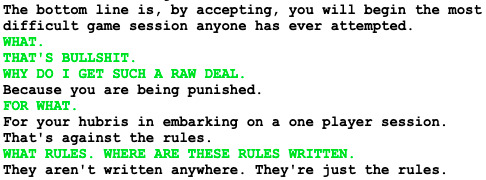
But the narrative rules it draws attention to are often all its own. See, in some ways the setting of Homestuck is meant to be an obvious set of fantasy Bildungromane. The characters enter a game world, Sburb, and are each deposited on a planet with almost stock templates: Land of Wind and Shade, Land of Heat and Clockwork, etc. Each are filled with a population of simple game constructs with little personality outside of what's needed to drop lore tidbits, and a slumbering denizen connected to a personal quest tailor-made for the player. This sense of "generic fantasy world made for a generic fantasy quest" is heightened by Homestuck's constant references to other media containing famous lands constructed from fantasy stories: Peter Pan/Hook, the Wizard of Oz, Alice in Wonderland, Don Quixote, and The Neverending Story. (That last example makes up not only a substantial amount of aesthetic references, but also structural echoes; as Homestuck copies it by having a second half in which reader-stand ins enter the story, characters go from one world to another, and the role of author and audience gets muddled in a world-threatening manner.)
It seems like the game Sburb created the players different worlds to facilitate a typical Bildungroman adventure. Enter the fantasy land, meet the locals, learn the lore, defeat the monster. Unlike Jacob's Bell, The Lands of Homestuck don't make sense as anything besides a game construct, a way to facilitate this narrative arc. And the character's tendency to sidestep the quests set up by the Lands and skip through or break things feels like a subversion of those typical sorts of fantasy stories.
A complicating factor, though, is that the game was set up with the expectation that the players would skip around and break things. The entire game is composed of a series of time loops, including the characters creating themselves, creating the big bad in an attempt to defeat him, etc. Everything that happens in a game session was engineered to happen "by" the game—including the parts that seem to break the intended narrative arc of the Lands. There's plenty of things that seem to be breaking the "intended" experience: Rose taking apart her game world, Vriska reading the mind of her Land's consorts to find out all the lore they have pre-programmed in, Jack Noir killing the Black King before the players could face him as the intended final boss. But all of these turn out to be essential conditions for the game coming to exist in the first place, for the characters to create themselves, for the Lands to be created as game constructs in the first place. The game creates conditions that require the players to "cheat."
In other words, its not just that the comic is subverting a typical fantasy story. Its that Sburb itself is a game that runs on the narrative rules. Not the narrative rules of a fantasy Bildungroman, but the narrative rules of a subversion of a fantasy Bildungroman. The subversion is expected and built-in.
This subversion-as-the-rule is something Hussie enjoys making the narrative conciet of a story: early Problem Sleuth was written with the one rule that the audience could never be right about how the main character's office worked. Its also a feature of Homestuck's general approach to characters and dialogue. I think a good example of this is Eridan and Feferi's early conversations. They get introduced as the primary examples of a form of alien romance the narrative just got done explaining, a pair of moirails that the narrator declares are "made for each other". But of course, the subversion of that is already built in, as before Eridan's full introduction we learned that he wanted to be in a different relationship with Feferi. So when the first few on-screen appearances of these characters turns out to be their break-up texts, its a "subversion" of the destined romance the narrator set-up, but its a sign-posted and expected subversion.
But back in terms of Sburb's mechanics: players of the game who perform a ritual to achieve god-tier status can only die if their death is either Heroic or Just: that is, they can only die if it’s narratively satisfying. If a powerful character dies without it being a satisfying heroic sacrifice or a satisfying end to a villainous rein of destruction—in other words, if the death is uninteresting and narratively pointless, then the character pops right back up. Like in Worm, plot armor is a mechanic of the setting that the characters can find out about and exploit, and like with Pact's boogeymen, characters become whole new types of beings as part of fitting to a character narrative that'd require plot armor. But unlike in wildbow's work, Homestuck's God Tiers have little in the way of diagetic justification. Hussie knows that there are situations where an audience won’t accept the stakes set out before them—they can tell that the bad thing can’t be allowed to happen, because if it did the plot couldn’t continue or the story would suffer, so they know the bad thing won’t happen. Accepting this, they play around with the trope by having it literally impossible for the bad thing to happen if the story would be worse for it.
But where it gets weird is how this plot-armor mechanic gets applied to Gamzee, in one of my favorite sections of Act 6. Gamzee was introduced as a joke character riffing on the juggalo evil clown subculture, who later goes on a murderous rampage for reasons that are never made fully obvious in-text. He then scuttles about the story as a figure who keeps breaking the story’s rules: both the mechanical rules of how Sburb works and the rules of storytelling generally. This ramps up a lot in Act 6, where he puts on a fake god-tier outfit and starts showing up at times and places he should not be able to be based on the established mechanics of Sburb, which up until then had been incredibly strict parameters on the story. Unlike a lot of the items that loop back in time in convoluted ways, we don’t see how Gamzee appeared on Jane’s planet, or went to the future to raise the cherubs, or all the other shit he gets up to. And we aren’t given a reason for why he’s selling blood like an RPG merchant or why he’s raising the big bad or why he’s doing anything at that point. He becomes a deus ex diabolica, a character whose not really a character at all so much as someone who sets up the obstacles in the story and has no reason for doing so besides the fact that the story wouldn’t work if he wasn’t there to set up the stakes.
One especially odd thing about him though is that even though he never actually reached God tier, he seemingly couldn't be killed.

At first this seems weird. Gamzee is breaking a core mechanical rule of Homstuck: he's immortal despite not being God-tier. But then you remember that the mechanical rule of God-tier immortality was already just a formalization of a narrative rule: a character can't die if the story isn't done with them. Homestuck is breaking its diagetic rules, but following the narrative rules they reflect.
This meta-interpretation of Gamzee's immortality is strengthened by the fact that the above conversation is taking place between Andrew Hussie and one of their characters. Furthermore, said character is a fandom stand-in who later transitions into being an author stand-in. This character (Caliborn) is the main villain of Homestuck, and has been interpreted as everything from the chains of narrative inevitability, to the interface of the webcomic itself, to Homestuck readers with an unhealthy relationship to the work, to the viler tendencies of Hussie themself present throughout the comic.
Not the only such stand-in; nearly all the villains of Homestuck assume some authorial role, as Hussie has an ongoing theme of equating the author role to being a manipulator. Thus the most heroic characters generally are reactive rather than proactive, thus Doc Scratch/Vriska/Dirk/etc all trying to author the timeline or claim causal responsibility for events while manipulating other characters, etc. But Caliborn ends up representing some more of Hussie's specific creative tendencies, and is the only character that Hussie's in-comic self has a conversation with.
Notably, this conversation has pretty much the only instance of Hussie presenting all the weird obstacles of Sburb as something they've set up as the author.
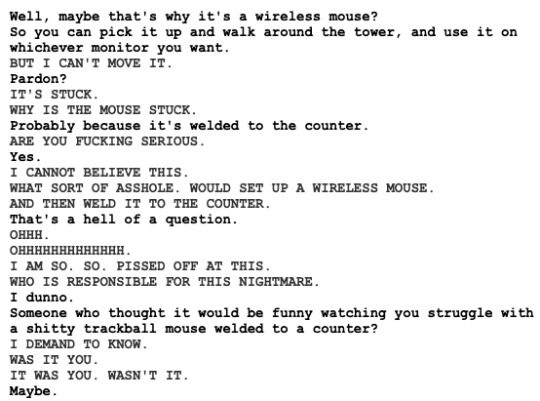
Oddly enough, apart from this, the yellow yard, and the Spades Slick sideplot, "Hussie" as a character has all but no role in the story. Which is in keeping with their (possible farcical?) ethos of all their characters existing as their own entities/character types, with Hussie just expressing them. The Entities in Worm actually end up being more direct author figures than Andrew Hussie's own self-insert, since they at least perform the role of authors (control characters in a way that produces dynamic and interesting scenarios).
This is a part of why the Hussie stand-in apparently lacks knowledge of their own story, and gets surprised by it.
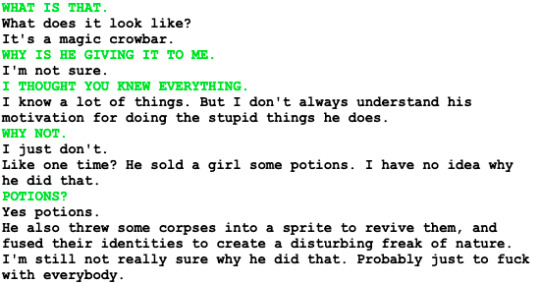

Hussie claims even they don't know where Gamzee got things, what he gets up to, or why he's doing what he's doing. The first two things are probably true, honestly. The actual author Hussie may not have an idea in mind for how Gamzee gets to any of the places he does, since its not really relevant to the story. It feels weird that he doesn't, since so much of the rest of Homestuck is tracking how various objects travel from one point in a timeline to another, but when there's no interesting answer to be constructed by the author none really has to be provided. Again, by this point Gamzee is a plot device that Hussie has dressed up as a funny clown for the audience's amusement, he's not really a character.
But if the Hussie stand-in is meant to be taken seriously when they say they don't know why Gamzee has the keys, then there's a disconnect between Hussie the character and Hussie the author. Since the keys do have a plot purpose that's revealed almost immediately, and that Hussie almost certainly had planned.
A weakness in metafiction generally is that having the author be a character in any real capacity lowers they're ability to be a true author figure. If the stand-in is surprised by something the author wrote, then they're not reflecting the author. If the characters kill the author stand-in, but the story keeps on going, then what the hell was the author representing?
IV
The only piece of metafiction I've seen that squared that circle is EIDOLON DISKA, which mostly suceeds because of its structure as an actual-play. It has a GM who serves as a narrator alongside being the voice of almost all the characters, but all the main characters are acted out by other people. So it can pull a lot of the standard metafiction moves in much more convincing ways. The narrator reveals that he's an in-universe character who they actually know, and whose been writing the story they're all in. When the player characters are still able to rebel and fight against the narrator, it works, because the PCs actually are representing other people making decisions apart from the GM. Even a character usurping the author ends up working, since it just means that character's player becomes the GM.
As you'd expect, EIDOLON DISKA is another piece that blends diagetic and narrative rules. Gods currently writing the story (aka the current GM) can't rewrite portions that previous gods wrote, because doing something so narratively unsatisfying would break their own godhood. Breaking the rules of the Eidolon rpg system also risks being usurped, since they're the narrative rules the story runs on, and the diagetic rules of Godhood are just narrative rules.
This gets most interesting when the characters end up dying, as will sometimes happen in an actual-play of a ttrpg where death is a mechanic. The podcast is divided into two time periods, with the first group being the founding members of their school's mystery solvers club. The second group are the members of the same club 20 years later, trying to solve the murder of the founders. Because the first group's death is a set event that the narrator already wrote would happen at a specific time, every time the characters in that first group die before that point, they have to come back. And once it becomes clear that they're characters, they become aware of this, and start abusing it. They take bigger risks, stop freaking out when their friends get hurt or killed in battle, start getting chatty with the increasingly annoyed grim reaper—in other words, they realize they have plot armor and start acting like it. Since they're aware of and secure of their plot armor, they use it more fully than Blake does. And since its an actual play instead of something written by one person, they're actually able to use that plot armor to be more than a villain thrown into heroes way like Jack Slash or Gamzee. DISKA isn't finished yet, but I have the most hope for it going into interesting places with plot armor out of any of these stories.
#wormblr#parahumans#homestuck#eidolon diska#eidolon playtest#wildbow#andrew hussie#Youtube#pactblr#otherverse#mals says
122 notes
·
View notes
Text
i KNOW people have done this before i have, but some strange things in the first few episodes of the new doctor who that might be foreshadowing something
the doctor using some of his regeneration energy on the butterfly
constantly correcting himself from "babies" to "space babies" - why? whats the difference? what's the point?
breaking the fourth wall !!?? winking to the camera and pointing out diegetic vs non-diegetic music??
→ i saw a theory they might be like. stuck in a TV show or something. the reference to “visiting star trek" could also fall here. but idk
bringing up his children multiple times already after so long of never mentioning susan, continually saying “dad to dad” to the anglican, etc.
kate in 73 yards: “the timeline might be suspended along your event.” what event? the woman? the fairy circle? ruby’s entire life? was it all an alternate universe or was “real” time paused for all of that to play out? what does it mean!??
anyway what the fuck even was 73 yards. thats like my worst nightmare bro. where did he go. how does the time loop work if old ruby stopped it all from happening. was that old ruby the whole time following her (i dont think so). what does it mean? what does it all MEAN????
#doctor who#ruby sunday#the doctor#ncuti gatwa#millie gibson#tv shows#what does it mean. what does it MEAN
87 notes
·
View notes
Text
Maestro, Ms. Flood and non-diegetic sound: a theory on what the fuck is happening in Doctor Who
okay my brain is still tremendously scrambled after everything we just saw but i have a theory...HUGE spoilers for the new Doctor Who eps (especially The Devil's Chord):
so we know by know that Maestro is the Toymaker's child...and it seems that the Toymaker's Legions may well in fact refer to his children.
in The Devil's Chord, there's an interesting throwaway line from the Doctor which could be read as a joke: "I thought that was non-diegetic." The Doctor here is referring to the rising crescendo of background music: non-diegetic sound is sound that we, the audience, can hear, but doesn't exist within the film's universe. so when a couple are embracing and a beautiful love melody plays in the background, we can hear it, but the characters can't.
now, this implies that in general, the Doctor is able to hear non-diegetic sound...but he understands that other people can't. the fact that Ruby is able to hear this non-diegetic sound is a violation - it's not supposed to happen.
you know what else isn't supposed to happen? the way Maestro speaks to, and winks at, the audience. we see that Maestro has inherited quite a few traits from their father, and we know from The Giggle novelisation that the Toymaker is capable of fourth-wall breaking and metacommentary (e.g., writing a book in the Doctor Who canon, for instance). similar moments include Maestro playing the Doctor Who theme for the opening credits, and playing a distorted version of it later in the episode.
there is one other character who has spoken directly to the audience and broken the fourth wall: Ms. Flood. here's my theory:
i believe that Ms. Flood, like Maestro, is one of the Toymaker's children, and therefore one of his Legions. i also believe that she embodies some sort of form of storytelling, the way Maestro does music, and this gives her the ability to transcend form and break the fourth wall. and i absolutely believe she is directly responsible for the snow which keeps filtering through Ruby's memory. something about her presence and existence is melting the boundaries between fiction and reality.
now, there are a few loose ends. i don't know what role Harbinger (the small boy from the beginning of the episode) plays...Maestro describes him as their 'prelude', and Harbinger calls Maestro their 'daddy'. it may well be that Maestro is Harbinger's parent the same way the Toymaker is Maestro's father. however...because we see him still around at the end of the episode, i believe that Harbinger is a prelude to another character.
perhaps he is, in general, a Harbinger of doom.
and a prelude to a Flood?
[edit] i nearly forgot - i am convinced this melting of the boundary between fiction and reality is why we had a musical at the end, and the Doctor and Ruby didn't notice
#i am desperate to hear other people's thoughts on this please throw your own theories my way#doctor who spoilers#doctor who#maestro#the toymaker#ms flood#harbinger#the doctor#ruby sunday#fifteenth doctor#dw#starleskatalks#long post
77 notes
·
View notes
Text
ok but all the fourth wall breaks in this episode was crazy - maestro and the doctor winking to the audience (just like mrs flood did in the christmas special!!!), maestro playing the dw theme and the doctor talking about how he thought the music was non-diegetic? WILD. ABSOLUTELY WILD. like what is going on here??? is it gonna be related to all the gods/folklore/mythology stuff? something about how the audience is bringing stuff to life? i genuinely have no clue but i cannot fucking wait until next week for this
77 notes
·
View notes
Text
From what I can tell, I can classify the mysteries so far into 5 main mysteries:
The Mrs Flood Mystery
The Susan Twist Mystery
The Mystery of The One Who Waits
The Mystery of Ruby Sunday’s Mother(??) Parent
The Mystery of Ruby Sunday
And here are my thoughts and theories on each of them (as well as fourth-wall breaks, and theories I do not like):
Mrs Flood:
She is Susan. I believe that ‘Susan’ Twist is a red herring, and Susan deserves her return. The fact that Ruby mentioned that she would be living in her time makes me even more sure, especially considering Ruby’s tendency to make things ‘happen’ - Strictly, Star Trek - more on that later.
She is River Song. A huge jump in likelihood, because I do believe her story is over, but you never know, and I don’t think I would be complaining about her return particularly. We don’t know Mrs Flood’s first name, which might be for a reason. Melody Pond, River Song and then xxxx Flood.
She is the One Who Waits. I’m going to probably say this about everyone but… idk what else to say. sHe’S tHe RaNi!!!11!!
Susan Twist:
She is the One Who Waits/part of the Pantheon of Gods. It just seems likely.
She is Ruby/Ruby’s mother. Seems the least likely, but in that case it would be a situation of ‘watching over’ Ruby in a way, but Susan Twist looks nothing like Ruby, so very unlikely.
She is no one/a spy. This works well for my first point regarding Ruby’s parent, but I think she might be a spy for The Trickster to keep an eye on the Doctor/Ruby. They could also be the same thing as the ‘Bad Wolf’, ‘Torchwood’ and ‘Vote Saxon’ - they don’t make sense until the finale, she might not make sense until the finale.
The One Who Waits:
Obviously one of the pantheon of Gods - I do believe the most powerful.
Probably Ruby’s mother, or someone related to Ruby.
We don’t know who they are yet. Some new guy. Hoping any one of these.
Ruby’s Parent:
THE TRICKSTER FROM THE SARAH JANE ADVENTURES! The hood and cloak are the same, the desolate London is so similar and the theme when Maria has The Trickster’s box in her bed and when Ruby was hoisted into the air is the same - please just search on youtube, it will probably be there. Plus, The Trickster would work well with the Pantheon of Gods - the Gods of CHAOS - what The Trickster thrives on.
A powerful being from the Gods of Chaos - an evil thing, the One Who Waits.
Someone the Doctor may recognise - though I doubt it somehow.
Ruby:
The daughter of one of the Gods of Chaos - you cannot deny her powers, in terms of the snow, mentioning things and then they exist - she mentions the Butterfly Effect- it happens. She mentions Star Trek in Space Babies, and the crew are dressed in uniforms eerily similar to the Star Trek ones. She mentions Strictly - who come but Johannes and Shirley from Strictly.
A supernatural entity - like a changeling, or something like that. The DNA scan said she was human, but it was only 70% done - that might be foreshadowing something - in terms that she is not human. In The Wild Blue Yonder, The Doctor let superstition come in - maybe he also let Ruby in.
A bad guy. One of the Gods of Chaos, the One Who Waits. Getting close to The Doctor all this time… maybe this won’t even be revealed until series 15. That would be great in my opinion honestly!
The last episode - ‘The Legend of Ruby Sunday’ makes me believe that she is older than she is. It is not the story, it is the legend - the Google definition being ‘a traditional story sometimes popularly regarded as historical but not authenticated. Not a word being used for a 19-year-old girl from Manchester, methinks.
Fourth-wall breaks: The Legend of Ruby Sunday seems to be based on a TV show - now we get to the ‘Doctor Who’ is a TV show in ‘Doctor Who’ - e.g. The Doctor can hear the non-diegetic music. I think this is a great idea. (I have written a fan-fiction about this 2 years ago hehe).
I DO NOT think these theories are true:
The Doctor is Ruby’s parent. Nope. Too obvious, lazy and just plain weird.
Ruby is Ruby’s parent?? Weird and impossible. Very very timey-wimey.
The Master is returning - I don’t think they are this series - keep in mind that we only last saw them 6 episodes as of now (after Boom - not counting The Tooth).
THANK YOU READING IF YOU’VE READ ALL OF THIS!!!
#doctor who#15th doctor#ruby sunday#ncuti gatwa#millie gibson#doctor who series 14#doctor who season 14#doctor who series 1#doctor who season 1#nuwho#new new who#doctor who theories#susan twist#mrs flood
50 notes
·
View notes
Text
The Devil's Chord! This was my most highly anticipated episode of the series because of The Beatles - who I'm very nostalgic for, sue me - but they had a much smaller part than I expected. That may be for the best, as the actors don't look anything like the real deal, but they did an admirable job considering the circumstances.
I love the idea behind this one. I'm a musician myself and love things about music. Music being important, music being holy, I love it all. Everything from Maestro playing us into the theme tune, to the way it aligns with the characters' established personalities (the Doctor's jukebox and Ruby's band), made me very happy. The music battle was especially cool. Very The Devil Went Down to Georgia. Out there, but I liked it a lot.
Maestro was also a lot. I liked them, though. Great costumes, great performance. A campy villain in the best way. They're the Toymaker's child, which is interesting in itself, and I like that the rules around fair play seemed to extend to them as well.
There was a lot of series arc stuff here. So, Ruby has Carol of the Bells deeply ingrained within her. There was some important figure (another of the Pantheon, presumably) at her birth - is Ruby herself a child of the Pantheon? More snow, as well. There's also the One Who Waits coming up again. It all feels a little too self-conscious and crammed in - "remember, there's pay-off coming for these random mysteries that you have no context for!". I know we live in an era of heavily serialised media, in large part because of streaming and the binge model, and obviously Doctor Who has been semi-serialised since the revival, but it just seems like a lot. Maybe even too much, especially since the first episode was quite heavy with it too.
Although, I did wonder if this one was meant to be later in the series. First Ruby saying "you never hide" and then "you always know what to do" signaled a far longer association with the Doctor than she has had, but then it was especially jarring when she said it was hard to keep track of when her time is and it could be June or July... That sounds like someone who's been travelling with the Doctor for a while, not like someone who's on their second trip. And it was Christmas for her only last episode. Obviously there can be off-screen trips, but usually for the first couple of episodes we want to feel that this is the start of their journey as the audience gets to know them. Did this get plucked from later in the series and dropped into the episode 2 slot? Because it seems a bit of a shame, if so.
There was a lot of fourth wall breaking in this one as well. There was a wink to camera each from Maestro and the Doctor, as well as the Doctor's comment about thinking the music was non-diegetic (a nice little moment that probably a lot of people will miss). I do quite like a meta moment, and particularly loved the Twelfth Doctor's partaking in them, but I wonder if these serve a particular purpose, because we also had Mrs Flood talking to camera at the end of the Christmas special. Since RTD seems to be going with a theme that the rules of the universe have changed and become a bit more magical, I wouldn't be surprised if the meta elements tied in somehow.
Then, this is less meta and more fully surreal, but that whole ending musical number was... odd. I don't know what I think about it yet. The Doctor with his wink and "there's always a twist at the end" seemed to signal that we were leaving the normal reality of the show, but then... Did that musical number literally happen? How about the Abbey Road zebra crossing acting like a piano? It's part of my specific brand of autism that I struggle with surreal things when it's not clear how/whether they relate to the more realistic things going on, so maybe other people love it. It just made me feel confused, though, and slightly annoyed. I expected a musical number because the trailers showing this made that fairly clear, but I'd assumed it would be explicitly connected to the strange happenings of the episode. Instead it's just plonked at the end after everything has been fixed.
A lot of this latter stuff sounds quite negative, but overall I really liked this one! As I said before, the music stuff speaks to me personally very much, and I'll withhold final judgement about the serialisation stuff and even the meta/surreal stuff, as it may well pay off yet.
Small things
Love their outfits so much, and obviously we've known about them for a while, but it was funny they were worried about blending in when both of them (especially Ruby) were wearing pretty 60s adjacent outfits at the start. The Doctor was more 70s, but I don't think many people would have looked askance.
Ahhhh, Fifteen mentioning that One was in the junkyard made me exceedingly happy! The speculation about what happened to Susan also has me hoping beyond hope that this might be set-up for a Susan return.
I loved that extended instrumental scene where Ruby just played on the rooftop and people listened. It was quite moving!
Love hearing the word "lesbians" on Doctor Who <3 - I don't think even Bill explicitly got to use that word!
Just the general queerness is really nice. Ruby writing a song for her friend's gay break up. Maestro being they/them and it not really being a thing beyond their introduction. Ruby's mum having a "girlfriend" who was a Beatles fan that makes me wonder if that's in the platonic or gay sense.
I want to know the behind the scenes details of how they chose the music they did, especially when it comes to the chords that both summon and banish Maestro.
Henry the child is real and alive at the end! (Though it's during the musical number, so I guess real is dubious.) When he vanished into nothingness (and his music teacher didn't seem to care), I had thought he wasn't real. Does he have his own world-ending powers?
The Doctor referring to bigeneration as having had his soul "torn in half". Hmm, don't like that! I won't rehash my feelings on bigeneration here, but this implies that there is not continuity between the end of Fourteen and the start of Fifteen, which mucks up one of the only ways I could hold onto being just about okay with it.
#doctor who#the devil's chord#mine#dwmine#reactions#doctor who spoilers#dwspoilers#it's not even a good musical number#oh well#also the susan thing has me genuinely very very hopeful#please please please bring back carole ann ford while you still can#and obviously if you do bring back susan she had better be played by carole ann ford#dwe15
26 notes
·
View notes
Text
"I thought that was non-diegetic" You guys don't know how happy that line makes me oh my gosh what a fun way to break the fourth wall
25 notes
·
View notes
Text
a story about obsession, particularly with a piece or form of media, taking over the main character's life to the point where it begins to solely define it
uses issues with literal eyesight/perception (blindness, hallucination, obstruction of view, etc) to illustrate this obsession
main character haphazardly journeys into a vast unknown abyss in the hope of understanding the object of their obsession
strained relationship between a character letting a sole obsession take over their life and a corresponding character trying to get away from the object of that same obsession, by any means necessary, and yet it's clear at the end that said characters still deeply care for one another
breaks the fourth wall using the format of the medium itself (footnotes, fonts, watermarks, etc)
more specifically, by taking EXTRADIEGETIC formatting elements and making them DIEGETIC (i.e. characters IN the story are aware of them)
even MORE specifically, strategically uses the color blue to continuously remind the IRL viewer/reader/whatever of the (omni)presence of the object of obsession
cameos from basically every well-known person ever in the IRL field/community related to the story, and also several not
official music associated with the story fucks severely
guy with a first name starting with "s" and the last name "wozniak" is extradiegetically referred to as "woz"
is a piece of media im normal about (lying)
borderline forever is gamer comedy house of leaves
#gets a little fuzzy since point 4 changes which wozman is will navidson (terry instead of scott)#but the idea of Jeb Jab Is Karen Green is too funny to pass up#wozniak/woz moment in house of leaves is on page 361 and refers to steve wozniak. from apple#house of leaves#scott the woz#borderline forever
58 notes
·
View notes